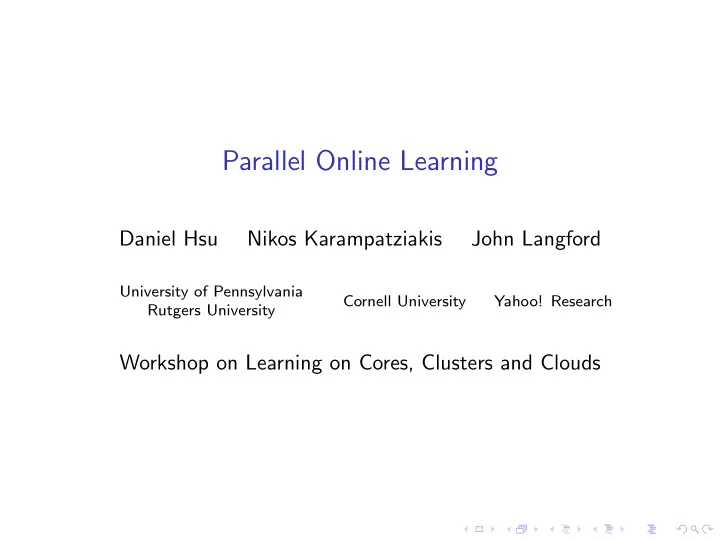

Parallel Online Learning Daniel Hsu Nikos Karampatziakis John Langford University of Pennsylvania Cornell University Yahoo! Research Rutgers University Workshop on Learning on Cores, Clusters and Clouds
Online Learning ◮ Learner gets the next example x t , makes a prediction p t , receives actual label y t , suffers loss ℓ ( p t , y t ), updates itself ◮ Simple and fast predictions and updates w ⊤ x t = p t = w t − η t ∇ ℓ ( p t , y t ) w t +1 ◮ Online gradient descent asymptotically attains optimal regret ◮ Online learning scales well . . . ◮ . . . but it’s a sequential algorithm ◮ What if we want to train on huge datasets? ◮ We investigate ways of distributing predictions, and updates while minimizing communication.
Delay ◮ Parallelizing online learning leads to delay problems. ◮ Temporally correlated or adversarial examples. ◮ We investigate no delay and bounded delay schemes.
Tree Architectures y ˆ y 2 , 1 y 2 , 2 ˆ ˆ y 1 , 4 y 1 , 1 y 1 , 2 y 1 , 3 ˆ ˆ ˆ ˆ x F 1 x F 2 x F 3 x F 4
Local Updates Each node in the tree: ◮ Computes its prediction p i , j based on its weights and inputs ◮ Sends ˆ y i , j = σ ( p i , j ) to its parent 1 ◮ Updates its weights based on ∇ ℓ ( p i , j , y ) No delay Representation power: between Naive Bayes and centralized linear model. 1 The nonlinearity introduced by σ has an interesting effect
Global Updates ◮ Local update can help or hurt. ◮ Improved representation power by more communication. ◮ Delayed global training ◮ Delayed backprop For details and experiments come see the poster.
Recommend
More recommend